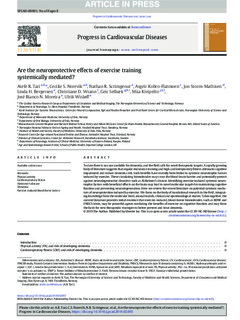| dc.contributor.author | Tari, Atefe R | |
| dc.contributor.author | Norevik, Cecilie Skarstad | |
| dc.contributor.author | Scrimgeour, Nathan Robert | |
| dc.contributor.author | Kobro-Flatmoen, Asgeir | |
| dc.contributor.author | Storm-Mathisen, Jon | |
| dc.contributor.author | Bergersen, Linda Hildegard | |
| dc.contributor.author | Wrann, Christiane D | |
| dc.contributor.author | Selbæk, Geir | |
| dc.contributor.author | Kivipelt, Miia | |
| dc.contributor.author | Moreira, Jose Bianco Nascimento | |
| dc.contributor.author | Wisloff, Ulrik | |
| dc.date.accessioned | 2019-04-01T08:28:02Z | |
| dc.date.available | 2019-04-01T08:28:02Z | |
| dc.date.created | 2019-02-27T13:09:14Z | |
| dc.date.issued | 2019 | |
| dc.identifier.issn | 0033-0620 | |
| dc.identifier.uri | http://hdl.handle.net/11250/2592619 | |
| dc.description.abstract | To date there is no cure available for dementia, and the field calls for novel therapeutic targets. A rapidly growing body of literature suggests that regular endurance training and high cardiorespiratory fitness attenuate cognitive impairment and reduce dementia risk. Such benefits have recently been linked to systemic neurotrophic factors induced by exercise. These circulating biomolecules may cross the blood-brain barrier and potentially protect against neurodegenerative disorders such as Alzheimer's disease. Identifying exercise-induced systemic neurotrophic factors with beneficial effects on the brain may lead to novel molecular targets for maintaining cognitive function and preventing neurodegeneration. Here we review the recent literature on potential systemic mediators of neuroprotection induced by exercise. We focus on the body of translational research in the field, integrating knowledge from the molecular level, animal models, clinical and epidemiological studies. Taken together, the current literature provides initial evidence that exercise-induced, blood-borne biomolecules, such as BDNF and FNDC5/irisin, may be powerful agents mediating the benefits of exercise on cognitive function and may form the basis for new therapeutic strategies to better prevent and treat dementia. | nb_NO |
| dc.language.iso | eng | nb_NO |
| dc.publisher | Elsevier | nb_NO |
| dc.rights | Attribution-NonCommercial-NoDerivatives 4.0 Internasjonal | * |
| dc.rights.uri | http://creativecommons.org/licenses/by-nc-nd/4.0/deed.no | * |
| dc.title | Are the Neuroprotective Effects of Exercise Training Systemically Mediated? | nb_NO |
| dc.type | Journal article | nb_NO |
| dc.type | Peer reviewed | nb_NO |
| dc.description.version | publishedVersion | nb_NO |
| dc.source.journal | Progress in cardiovascular diseases | nb_NO |
| dc.identifier.doi | 10.1016/j.pcad.2019.02.003 | |
| dc.identifier.cristin | 1681026 | |
| dc.description.localcode | © 2019 The Author. Published by Elsevier Inc. This is a n open access article under the CC BY-NC-ND license (http://creativecommons.org/licenses/by-nc-nd/4.0/). | nb_NO |
| cristin.unitcode | 194,65,25,0 | |
| cristin.unitcode | 194,65,60,0 | |
| cristin.unitcode | 194,0,0,0 | |
| cristin.unitname | Institutt for sirkulasjon og bildediagnostikk | |
| cristin.unitname | Kavliinstitutt for nevrovitenskap | |
| cristin.unitname | Norges teknisk-naturvitenskapelige universitet | |
| cristin.ispublished | true | |
| cristin.fulltext | original | |
| cristin.qualitycode | 1 | |

